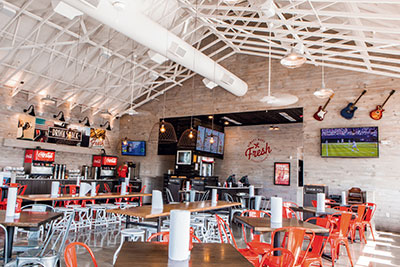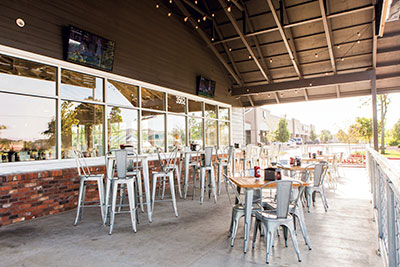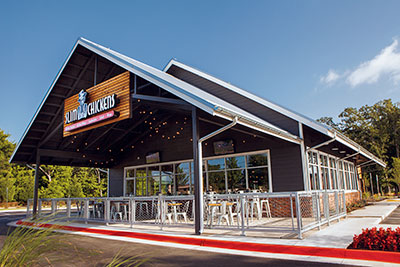This fast-casual chicken chain is counting on Southern hospitality and efficient operation to help it add more than 500 stores in the next decade.
 Southern-inspired interior design elements include wooden planks and exposed trusswork. Photo couresty of Slim ChickensInexperience in the restaurant industry is usually fatal to new operators. Sometimes, though, it can be freeing.
Southern-inspired interior design elements include wooden planks and exposed trusswork. Photo couresty of Slim ChickensInexperience in the restaurant industry is usually fatal to new operators. Sometimes, though, it can be freeing.
Take, for example, Slim Chickens, a Southern-style "better chicken" fast-casual operation based in Fayetteville, Ark. At the chain's founding 13 years ago, CEO Tom Gordon had only limited restaurant industry experience, while his longtime friend and partner, chief marketing officer Greg Smart, had no such experience at all.
This lack of experience usually serves as a recipe for disaster. In Slim Chickens' case, however, not having a playbook let the founders concentrate on the basics of hospitality industry success, Smart says. "We weren't limited or beholden to any kind of preconceived notions about how a restaurant should run, so we just ran it the way we felt we want to be treated and want to be served. That really led to our cornerstones, our core values of great customer service, great products."
Those core values helped the chain catch on quickly, and they represent the ultimate drivers behind its growth to roughly 35 stores. While Slim Chickens has naturally invested in the people and processes needed to become a major chain, those values still drive the operation and its aggressive expansion plans. They're also evident in the restaurant's design.
Brand and Front of the House
 The pitched roof gives Slim Chickens restaurants an open, airy feel, allowing them to have a smaller footprint. Photo couresty of Slim ChickensBetter chicken is an emerging segment in the fast-casual sector, one that its proponents believe can take off like the better-burger and fast-casual pizza operations before it.
The pitched roof gives Slim Chickens restaurants an open, airy feel, allowing them to have a smaller footprint. Photo couresty of Slim ChickensBetter chicken is an emerging segment in the fast-casual sector, one that its proponents believe can take off like the better-burger and fast-casual pizza operations before it.
To stand out in this sector, Slim Chickens has fully adopted a Southern-style concept. Its menu includes fried chicken wings and chicken tenders, along with chicken and waffles, a Southern comfort food classic. Healthier options include grilled chicken sandwiches, wraps and salads.
Southern also shows up in the chain's approach to hospitality. Slim Chickens trains team members to greet customers as they enter and then walk guests through the menu. Once customers take their seats, Slim Chickens doesn't want to force them up: table runners will bring out food, get refills and pre-bus tables, making it a very high-touch experience for a limited-service restaurant. "We're very authentic Southern hospitality. We'll absolutely take care of you in the dining room," says Sam Rothschild, partner and chief operating officer.
The restaurant's architecture is also Southern. All Slim Chickens locations have an outdoor patio — which the chain calls "the porch" — covered by a pitched awning with trusswork, calling to mind a barn or older Southern home. In freestanding stores, the entire building features a pitched roof and interior trusswork wherever a municipality allows it.
 The Slim Chickens patio — called “the porch” — is designed to drive home the chain’s Southern brand as well. Photo couresty of Slim ChickensThese design elements not only help create the Slim Chickens customer experience, they also reduce construction costs, says Smart. "All interiors have open trusswork, so you get a really lofty feeling when you're inside the space. That's kind of a psychological play. We don't have to build a large physical plant as far as square footage, but the open truss makes the restaurant feel open and airy and inviting."
The Slim Chickens patio — called “the porch” — is designed to drive home the chain’s Southern brand as well. Photo couresty of Slim ChickensThese design elements not only help create the Slim Chickens customer experience, they also reduce construction costs, says Smart. "All interiors have open trusswork, so you get a really lofty feeling when you're inside the space. That's kind of a psychological play. We don't have to build a large physical plant as far as square footage, but the open truss makes the restaurant feel open and airy and inviting."
Several interior design elements also reinforce the restaurant's Southern theme. Wall coverings include 1-by-10-inch whitewashed wood planks, while wall decor includes guitars, a clear tie to the chain's name and to the Southern blues playing in each store.
Importantly, not every Slim Chickens customer experiences this Southern theme. Since day one, the restaurant has offered drive-thru service. Today, drive-thru accounts for 45 percent of Slim Chickens' sales, with very little overlap between dine-in and drive-thru customers.
While drive-thru patrons don't get the music and the table service, the chain does take steps to provide them with good customer service, with a focus on speed, Rothschild says. "The customers in the dining room, our target is to get their food in five minutes once they sit down. It's fresh, we cook it to order. People want a drive-thru experience much faster. We're very conscious of the fact that we need to speed up that process."
To help facilitate speed of service, the drive-thru menu board showcases items the kitchen staff can produce quickly. The chain also uses tablet ordering technology. During periods of peak demand, a crew member will go to cars in the queue, take orders and accept credit card payments. "It really speeds up the process," says Rothschild.
The kitchen setup also reflects Slim Chickens' two service models. Since the chain needs to produce food for drive-thru customers more quickly than for dine-in, each has its own set of kitchen display system monitors. Team members give priority to drive-thru orders.
A Simple Kitchen
The addition of tablet ordering and dual kitchen display monitors goes part and parcel with one of the biggest changes in Slim Chickens' history.
According to Smart, the company's focus on the basics of food and customer service allowed it to grow at a good pace for a new operation, with its second and third stores both opening within four years of the first restaurant. At that point, Slim Chickens' founders realized they needed to invest in the processes and people in order for the concept to really take off. "The brand has legs. How do we maximize our efficiency, essentially to make it a little easier every time we grow? The restaurant industry is tough. You don't want to fight your equipment the whole time," says Smart.
Over the next several years, the operation built its franchise system (launched just two years ago), formalized its training processes and invested in human capital. This effort included bringing on board Rothschild, a 40-year industry veteran, as a partner and head of operations. One of Rothschild's most important duties is making sure the kitchen is as efficient as possible, both in terms of the flow of work and in the performance of individual pieces of equipment.
According to Rothschild, Slim Chickens' focused menu allows its kitchen and processes to be relatively straightforward.
The production line begins with the breading station, where staff bread wings and tenders in one bin and fried produce like pickles and mushrooms in another. A nearby refrigerator holds these items until cooking. Next to the breading station sits the operation's fryer bank, which consists of four fryers with three baskets each.
 Slim Chickens communicates its Southern style through architectural elements that include a pitched roof and exposed trusswork. Photo couresty of Slim ChickensGiven that the fryers serve as the chain's primary pieces of cooking equipment, the company pays close attention to their performance. "We moved on to a new set of fryers last year that have faster recovery times. Because we're breading a lot of our products, there's a lot of breading that falls into that grease. We have to filter our fryers several times a day. Our fryers need to be very efficient and effective to keep the grease clean, to make it user friendly for our staff. The fryers have to be able to keep and maintain temperature as we put the product in there all day long, so they have to be very reliable pieces of equipment for us," says Rothschild.
Slim Chickens communicates its Southern style through architectural elements that include a pitched roof and exposed trusswork. Photo couresty of Slim ChickensGiven that the fryers serve as the chain's primary pieces of cooking equipment, the company pays close attention to their performance. "We moved on to a new set of fryers last year that have faster recovery times. Because we're breading a lot of our products, there's a lot of breading that falls into that grease. We have to filter our fryers several times a day. Our fryers need to be very efficient and effective to keep the grease clean, to make it user friendly for our staff. The fryers have to be able to keep and maintain temperature as we put the product in there all day long, so they have to be very reliable pieces of equipment for us," says Rothschild.
While the chain aims to cook food to order, during peak periods it prepares larger batches of food. In those cases the wings, tenders and sides are held under heat lamps at the dump station next to the fryer.
When ready to serve the wings and tenders, staff take them to the next spot on the line, the sauce station, where the chain holds its eight different wing sauces, many made in-house. The production line closes with a small grill, where staff make grilled chicken tenders for salads and wraps.
At a nearby make table, which holds produce in wells and backup ingredients in undercounter refrigeration, staff finish salads and wraps. This station also holds one of the new additions to the kitchen: waffle irons for the chicken and waffles. Batter is held in a pitcher that's stored cold.
Though making the waffles is about as easy as cooking gets, integrating even this small piece of equipment proved challenging. "It moved its way around the kitchen the first month or two," says Rothschild. "We had a pretty set station. When you put something new into a station that wasn't designed to do it, it actually causes a little disruption in the line for a while until the operators figure it out."
Staff place complete menu items either in baskets for dine-in customers or paper disposables for the drive-thru — the only process difference for the two customer types other than the separate display systems.
The remaining portions of the back of the house mirror the simplicity of Slim Chickens' production kitchen. The chain's walk-in cooler holds fresh produce, wings and chicken, while the walk-in freezer (accessible through the cooler) stores fries.
Disposables take up most of the dry storage space, which also houses ingredients for waffle batter, and house-made dressings and sauces. These items are made in the prep area, which consists of little more than worktables and smallwares. "Hand-mixing old school — you've got a bowl, you've got a whisk," says Rothschild. The operation went this route over a countertop mixer to save money and limited counter space, though it is open to adding countertop equipment in the future, he notes.
With such limited prep work, a small number of food SKUs and a focused menu, Slim Chickens are far simpler to operate than many other chain restaurants, Rothschild says. That fact makes it particularly appealing to potential partners. "When we're working with franchisees and they're coming in to look at the concept, they're surprised and delighted by the lack of complexity of what we do. We're very efficient with that space."
Indeed, though franchising only launched two years ago, the company has already inked multiple deals. It expects to open between 20 and 25 stores this year and another 35 in 2017. According to Smart, the chain is aiming for 600 stores in the next decade, a number it is on pace to hit.
Even with an aggressive growth target, the chain is taking a measured approach to expansion. It is focusing on growth in concentric circles from its home base in Fayetteville. Slim Chickens pays particular attention to suburban communities in the mid South and Midwest, with the company's supply chain team helping identify markets where growth is possible and profitable. "We're being very disciplined and not growing too far from the home base," says Smart. "For us, the fresh product supply chain is very critical."
That commitment to controlled, managed growth remains in line with the company's longtime focus on quality service and products, first and foremost. It also demonstrates the successful integration of professionalized systems and processes into a corporate culture dedicated to quality.
"It's been a great growth curve as far as people joining the system who've seen the brand and want to be involved, from franchisees to employees to executive staff," Smart says. "We have a great culture and a great feeling, and people want to be a part of it. I feel that trickles down to the restaurant and to the guest experience." FE&S
The Slim Chickens patio — called "the porch" — is designed to drive home the chain's Southern brand as well.
Key Players
- Cofounder and CEO: Tom Gordon
- Cofounder and CMO: Greg Smart
- Partner and COO: Sam Rothschild
- Interior designer: Greg Smart
Facts of Note
- Kitchen design consultant: Internal
- Equipment dealers: Hockenbergs, Concept Services, TriMark
- Chain headquarters: Fayetteville, Ark.
- Year founded: 2003
- Signature menu items: Fresh chicken tenders and wings, handmade sauces.
- Number of units: 36
- Prototype FOH/BOH split: 60 percent FOH, 40 percent BOH
- Seats per unit (prototype): 120
- Location type: Free-standing, endcap
- Total system sales: More than $55 million (annualized)
- Unit-growth projections: 25 to 30 per year




